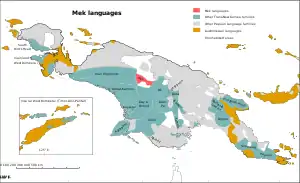| Mek | |
|---|---|
| Goliath | |
| Ethnicity | Mek people |
| Geographic distribution | New Guinea |
| Linguistic classification | Trans–New Guinea |
| Glottolog | mekk1240 |
 Map: The Mek languages of New Guinea
The Mek languages
Other Trans–New Guinea languages
Other Papuan languages
Austronesian languages
Uninhabited | |
The Mek languages are a well established family of Papuan languages spoken by the Mek peoples. They form a branch of the Trans–New Guinea languages (TNG) in the classifications of Stephen Wurm (1975) and of Malcolm Ross (2005).
Mek, then called Goliath, was identified by M. Bromley in 1967. It was placed in TNG by Wurm (1975).
Languages
The Mek languages form three dialect chains (Heeschen 1998):
- Eastern: Ketengban (including Okbap, Omban, Bime, Onya), Una (Goliath), Eipomek
- Northern: Kosarek Yale–Nipsan, Nalca
- Western: Korupun-Sela (including Dagi, Sisibna, Deibula)
Proto-language
Phonemes
Usher (2020) reconstructs the consonant and vowel inventories as 'perhaps' as follows:[2]
*m *n *ŋ *p *t *k *kʷ *(m)b *(n)d *(ŋ)g *(ŋ)gʷ *s *w *l *j
i u e o ɛ ɔ a ɒ
ei ou ɛi ɔu ai au aɛ aɔ
Pronouns
Pronouns are:[2]
sg pl 1 *na *nu[n] 2 *kan *kun (?) 3 *ɛl *tun, *[t/s]ig
The difference between the two 3pl forms is not known. 2pl and 3pl have parallels in Momuna /kun tun/.
Basic vocabulary
Some lexical reconstructions by Usher (2020) are:[2]
gloss Proto-Mek Proto-East Mek Kimyal Proto-Northwest Mek Proto-Momuna-Mek Momuna hair/feather *p[ɔ]t[ɔ]ŋ *pɔtɔŋ osoŋ *hɔŋ ear/twelve *aᵓ ɔ *aᵓ eye *atiŋ *asiŋ isiŋ *haⁱŋ *ɒtig ɒtù tooth/sharp *jo̝ *jo̝ jó tongue *se̝l[ija]mu *[se̝]l[ija]mu selamu *se̝l[i]mu foot/leg *jan *jan jan *jan *j[a/ɒ]n blood *e̝ne̝ŋ *ɪnɪŋ eneŋ *e̝ne̝ŋ *jo̝ne̝g bone *jɔk *jɔk jw-aʔ *jɔʔ[ɔ] breast *mɔᵘm *mɔᵘm moᵘm *mɔᵘm *mɔᵘm mɒ̃ᵘ louse *ami *ami imi *ami *ami ami dog *gam *[k/g]am gam *gam *gɒm kɒ̀ pig *be̝sam *bɪsam *bham wɒ́ bird *mak, *mag *mak -ma (?) *-ma (?) *mak má egg/fruit/seed *do̝[k] *dʊk do *do̝[k] dɒko ~ dɒku tree/wood *gal gal *gal *gɒl kɒ̀ woman/wife *ge̝l *[k/g]ɪl gel *ge̝l sun *k[ɛ]t[e̝]ŋ *k[ɛ]t[ɪ]ŋ isiŋ *he̝ŋ moon *wal *wal wal *wal water/river *m[ɛ/a]g *mɛk mag *m[ɛ/a]g fire *o̝ᵘg *ʊᵘk ug *[u]g stone *gɛⁱl; *gidig *[k/g]ɛⁱl girig *gidig kè path/way *bi[t/s]ig *bi[t/s]ik bisig *bhig name *si *si si *si *si si eat/drink *de̝-(b) *dɪ-(b) de- *de̝-(b) de- one *[na]tɔn *tɔn nason *nhɔn two/ring finger *b[e̝/ɛ]te̝ne̝ *b[ɪ/ɛ]tɪnɪ besene *bhe̝ne̝
Vocabulary comparison
The following basic vocabulary words are from McElhanon & Voorhoeve (1970),[3] Voorhoeve (1975),[4] and Heeschen (1978),[5] as cited in the Trans-New Guinea database:[6]
gloss Eipomek Korapun-Sela Nalca Una Yale, Korsarek Ketengban head kiisok asak huk heiyɔ´; khe yok giso hair fotong asuŋ hoŋ otoŋ hong; hɔŋ potong ear amol amalé amol eye asing isiŋ hiŋ atsiŋ heiŋ; hɩng asorue nose uu uryam u tooth sii si si tsi si tsi tongue sii tang selemú lyemngwe leg yan saŋ yan yan yan louse amnye wutnavu amnya ami; ami´ amnye dog kam kʰam; kham kam kam kam pig basam pham pham uduk pam; pham besam bird make winaŋ winiŋ mai winang; winaŋ ma egg duk waŋga doug winaŋ wana; winang wangká do blood ining iniŋ iniŋ eneŋ; ining yabye bone yoke iaŋ birin yog yok; you yo skin boxa phok kon breast taram saram taram tree yo kal; khal kal; khal kal co man nimi nim nimi woman kilape kəlabo nerape sky iim im im sun ketinge isiŋ hiŋ hein; hɛng getane moon wale wal ware water mek mak mek meye mak me fire uukwe uk uk uke ouk̂; ow ukwe stone kedinge khirik kirik waliŋ kirik gil road, path biisiik bi bisi name sii utnimi si si si eat dibmal dilom kwaːniŋ el dilamla; tiu loŋa jibmar one ton thoxunok nhon otunohon; se'lek tegen two bisini phein pɛndɛ; phende bitini
Evolution
Mek reflexes of proto-Trans-New Guinea (pTNG) etyma are:[7]
- mun ‘belly’ < *mundun ‘internal organs’
- kuna ‘shadow’ < *k(a,o)nan
- saŋ ‘dancing song’ < *saŋ
- getane ‘sun’ < *kVtane
- mundo ‘belly’ < *mundun ‘internal organs’
- ami ‘louse’ < *niman
- si ‘tooth’ < *(s,t)i(s,t)i
- tomo < *k(i,u)tuma ‘night’
- de ‘to burn’ < *nj(a,e,i)
- mon ‘belly’ < *mundun ‘internal organs’
- xau ‘ashes’ < *kambu
Further reading
- Heeschen, Volker. 1978. The Mek languages of Irian Jaya with special reference to the Eipo language. Irian 7(2): 3–46.
- Heeschen, Volker. 1992. The position of the Mek languages of Irian Jaya among the Papuan languages: History, typology and speech. Bijdragen tot de Taal-, Land- en Volkenkunde 148(3/4): 465–488.
References
- ↑ Momuna–Mek, New Guinea World
- 1 2 3 New Guinea World
- ↑ McElhanon, K.A. and Voorhoeve, C.L. The Trans-New Guinea Phylum: Explorations in deep-level genetic relationships. B-16, vi + 112 pages. Pacific Linguistics, The Australian National University, 1970. doi:10.15144/PL-B16
- ↑ Voorhoeve, C.L. Languages of Irian Jaya: Checklist. Preliminary classification, language maps, wordlists. B-31, iv + 133 pages. Pacific Linguistics, The Australian National University, 1975. doi:10.15144/PL-B31
- ↑ Heeschen, V. 1978. The Mek languages of Irian Jaya with special reference to the Eipo language. Irian 2: 3-67.
- ↑ Greenhill, Simon (2016). "TransNewGuinea.org - database of the languages of New Guinea". Retrieved 2020-11-05.
- ↑ Pawley, Andrew; Hammarström, Harald (2018). "The Trans New Guinea family". In Palmer, Bill (ed.). The Languages and Linguistics of the New Guinea Area: A Comprehensive Guide. The World of Linguistics. Vol. 4. Berlin: De Gruyter Mouton. pp. 21–196. ISBN 978-3-11-028642-7.
- Ross, Malcolm (2005). "Pronouns as a preliminary diagnostic for grouping Papuan languages". In Andrew Pawley; Robert Attenborough; Robin Hide; Jack Golson (eds.). Papuan pasts: cultural, linguistic and biological histories of Papuan-speaking peoples. Canberra: Pacific Linguistics. pp. 15–66. ISBN 0858835622. OCLC 67292782.
External links
- Timothy Usher, New Guinea World, Proto–Momuna–Mek
- (ibid.) Proto–Mek